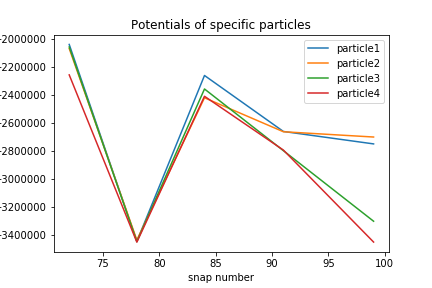I am calculating the potentials of particles in dark matter halos from the TNG-50 DMO simulation. I do not understand the results I am getting. I am looking at a few specific particles and tracing them across snapshots, gathering their potential from the 'Potential' field given in particle-level data files. For reference, I am looking at particles that belong to equilibrium halos at snapshot 99. They are the same particles in each snapshot because I tracked them using the 'ParticleID' field. The particles are seen having a massive decrease in potential followed by a massive increase around snapshot 78. I am confused as to how this is possible, as the halo is not undergoing any major event that would cause potential to increase. I have attached a plot for reference, it shows four particles with their potential on the y-axis and snap number on the horizontal access. Does anyone know why this could be happening?
Dylan Nelson
21 Jul '24
Assuming they are DM or stellar particles (whose IDs are constant and do not change), then the fluctuation you see must represent a true fluctuation of the potential.
Hello!
I am calculating the potentials of particles in dark matter halos from the TNG-50 DMO simulation. I do not understand the results I am getting. I am looking at a few specific particles and tracing them across snapshots, gathering their potential from the 'Potential' field given in particle-level data files. For reference, I am looking at particles that belong to equilibrium halos at snapshot 99. They are the same particles in each snapshot because I tracked them using the 'ParticleID' field. The particles are seen having a massive decrease in potential followed by a massive increase around snapshot 78. I am confused as to how this is possible, as the halo is not undergoing any major event that would cause potential to increase. I have attached a plot for reference, it shows four particles with their potential on the y-axis and snap number on the horizontal access. Does anyone know why this could be happening?
Assuming they are DM or stellar particles (whose IDs are constant and do not change), then the fluctuation you see must represent a true fluctuation of the potential.